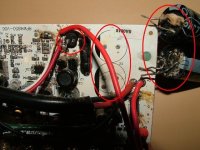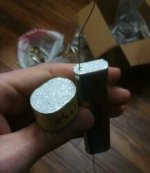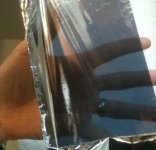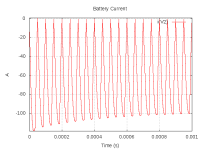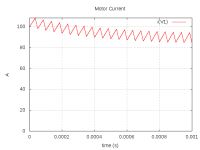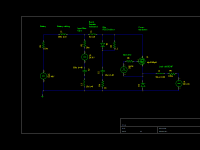Here are the three cap choices I had selected after much study and searching. When comparing cap choices, impedance/ESR should be as low as possible, and amps (ripple capacity) should be as big as possible (dont ask me why they list it that way). The lower the voltage rating, the better the performance specs are, but if the cap voltage is too close to your systems top-voltage and it spikes up over the cap rating, the cap will pop open like popcorn (also if you plug it in backwards...don't ask how I know that).
I'm told the uF number (physical size) of the cap doesn't help us at all (bigger is not better), its only the other numbers that are of concern.
12 mOhm, 4.28A, 35V, 3900uF,
http://search.digikey.com/scripts/DkSearch/dksus.dll?Detail&name=493-1602-ND
16 mOhm, 3.32A, 50V, 1000uF,
http://search.digikey.com/scripts/DkSearch/dksus.dll?Detail&name=P12393-ND
17 mOhm, 3.50A, 63V, 1800uF,
http://search.digikey.com/scripts/DkSearch/dksus.dll?Detail&name=565-1731-ND
26 mOhm, 3.86A, 100V, 820uF
http://www.digikey.com/product-detail/en/100ZLJ820M18X40/1189-1048-ND/3133977
27 mOhm, 3.51A, 100V, 680uF
http://www.digikey.com/product-detail/en/100ZLJ820M18X40/1189-1048-ND/3133977
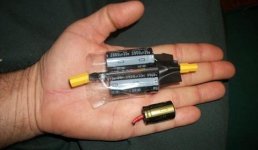
The two big caps on the pigtail are the 35V with slightly better specs than the 50V and the 63V. I am told 5V of ripple is bad, and with no added caps (just the two tiny ones from the factory) I was getting 4V of ripple with HARD acceleration.
I am told the most effective place to put the additional caps is as near as possible to the ESC on the power wire (red/black) inputs. Putting two the caps on a pigtail in-between the battery and ESC (4" from the ESC) still managed to drop the ripple to 1V (Not bad for $4 + shipping, recieved by mail in 5 days).
As you can see from the pic, the two 35V caps are twice as big as the 50V cap next to it in my palm (those are the only sizes Digikey had with the "best" specs). There is not a big difference in the specs, so today I tried the 50V caps on my 24V system to see if they would be slightly worse. On the Castle-Creations ICE-75A ESC data-logging, the brown peaks are the motor RPMs. I made two accelerations at the normal rate up to a stable speed of 20-MPH with
NO added caps, and the result was 3V of ripple (it was 4V with hard acceleration).
I plugged in ONE of the 50V caps and made two more runs, and the purple graph line shows it lowered the ripple to 2V. I plugged in TWO of the 50V caps, and made two more runs, the result being the ripple reduced to 1V (six test runs, then I rode home). Although these runs were made with normal acceleration (ESC programmed for soft start) I no longer feel the need for the larger 35V caps at all.
After also considering the minor differences in the listed performance of the 50V and 63V caps, I would definitely use the 63V caps on 44V-48V system, rather than risk the 50V caps on a battery fresh off the charger. However, be aware the 63V caps are about the same size as the larger 35V caps in the pic.
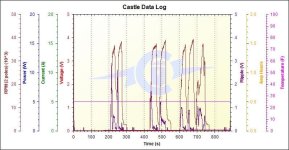
I am 180-lbs, level/flat/dry road with no wind, friction-drive on a fat 26" rear tire, using an Exceed 63mm diameter motor with a 295-kV and a 1.25" roller, 24V SLA pack (reading 26V), E-Sky servo-tester as a throttle. Data-logging showed I was drawing 60A on hard acceleration (1:26 reduction-roller/tire) and about 10A at top-speed cruise. If your system draws more amps than this, you 'might' need more caps than me to get the same result.
From deardancer:
http://endless-sphere.com/forums/viewtopic.php?f=2&t=5644&p=84577
...I put an oscilloscope on the various wires. To my surprise I found wild voltage swings, fairly high frequency spikes on the Battery positive line at the brushless controller; on a "constant" 26v input we had + spikes reaching over 50V and negatives going below ground. about 20 microseconds in width if I remember...This was a 24v Cyclone internal controller, but am suspicious that this might also be true of other controllers...Anyway, adding noise suppresion caps of sufficient size and voltage right at the controller incoming voltage line, and taking his accessory voltage tap closer to the pack, solved his problem...
Lukes lab:
http://endless-sphere.com/forums/viewtopic.php?f=30&t=22582#p328568
http://www.endless-sphere.com/forums/viewtopic.php?f=28&t=7992&start=925#p285835
from recumpense: "...You want the caps as CLOSE TO THE BOARD AS IS HUMANLY POSSIBLE!!!! I mean, even 5mm of added wire increases inductance the the FETs. So, get those babies EXTREMELY close to the board (ESC inputs)...."
http://www.endless-sphere.com/forums/viewtopic.php?f=28&t=7992&start=975#p295154
from AJ/Kim "...I sorted the voltage ripple problem I was having by the addition of a single capacitor ~1 inch from the board on the input wires, max ripple was 7.6V, now its 3.4V..."


